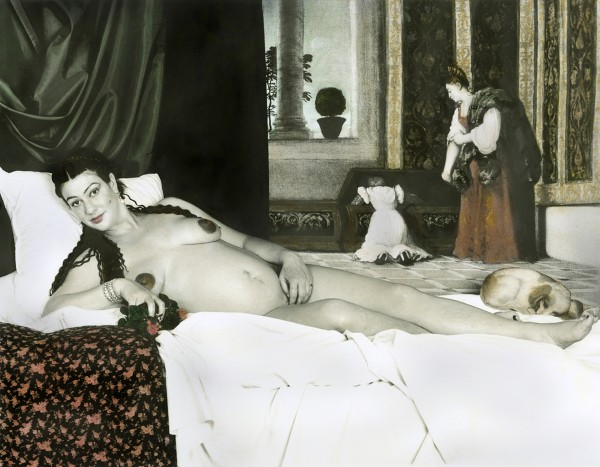
I interviewed sex worker artist Juniper Fleming on her collaborative photo series with other sex workers, Reclamation and (Dis)Atonement.
Your project consists of remaking iconic Western art works, creating photographic reproductions in which you replace the main figures in the paintings with sex workers. What does depicting sex workers in these roles achieve?
As sex workers we use the archetypes represented in these paintings every day in our performances, at work and in life. This history, and reality, of the feminine script is one that you cannot escape, but you can define your relationship to, through fantasy and inversion. As sex workers we are the inversion, at the same time as we are the embodiment, of the feminine.
How do you feel about the way sex workers are classically portrayed in the Western canon? I do recall some bright points, like all those gory paintings representing the triumph of heroic Biblical harlot Judith, when she beheads the general (and client) Holofernes for the Israelites. I was happy to see one of your photos is a riff on one of these paintings.
Well, first what has to be re-established from history is that sex workers were often models and muses for artists. Caravaggio often employed sex workers as models in his paintings. His piece ”Death of the Virgin” was rejected by the commissioning parish because it depicted the well-known courtesan, Fillide Melandroni, as the Virgin Mary. And the modern (Western) canon has painters such as Manet, Degas, Picasso, Toulouse-Lautrec, and Seurat divulging their fascination or at least proximity to sex work in their paintings. Many of them went directly to brothels to do some of their most famous work. Countless other times, however, our position as the model, muse, and/or subject has gone undocumented. These reimaginings are so important because they include us in celebrated and preserved artifacts, when so much of our history has been erased, deemed invaluable, throughout time.
Which model did you decide to use for each photo and why?
Actually, when a worker decides they want to collaborate with me on the project, they get to choose the painting. I have a growing index of paintings, throughout the span of art history, that represent the feminine in some way. Each person looks through that index, or comes with a painting I don’t have, and we go from there. Then we work together to design the props, with them collaborating as much or as little as they want.

Do you have a favorite photo from the series?
Honestly, my favorites are the ones I haven’t made yet. I love seeing a painting and imagining collaborating with one of my friends to reclaim it. It kind of makes all of history ours. Like we have declared the right to move freely throughout archetypes, time, and space. We are anything we project ourselves into.
In the text attached to Reclamation and (Dis)atonement’s visual art, you write, “In so many ways we are trained from birth for the job of a sex worker.” You quote John Berger, who said, “A woman must continually watch herself. She is almost continually accompanied by her own image of herself…She has to survey everything she is and everything she does because how she appears to men…” A sex working woman, then, is someone who consciously sells that image of a woman to her clients. How does this influence the way sex workers create images as artists? How does it influence you?
I think I can answer that by quoting another part of my text: “We give everything and nothing away by performing these already established ‘masterpieces,’ and it is within the lived duality of this performance that we offer something both to ourselves and to the reflected viewer.”
In the text, you talk about how a lot of sex work’s transgressive status stems from the fact that in women’s sex work, sex is not an “authentic” emotional revelation for a woman but a performance. Why do you think our culture is so hostile to the idea of women defining what sex means for themselves?
I’m glad you bring up that quote. I think the dynamics behind the extreme othering of sex workers by society is left thoroughly unexamined. The disingenuous slut/prostitute embodies a break in the social script, and refuses to be a symptom. This is the threat of present “other.”
Sex workers are often told that we are pathologically re-enacting childhood sexual abuse through our work. You write, that your deviancy—your sex work—is how you outlive your trauma. You claim defiantly that “being a victim and an agent are not mutually exclusive.” Can you talk about this way of redefining being both an abuse survivor and a sex worker?
I feel that sex workers are so often forced to deflect this victim/empowered dichotomy that we rarely get the chance to define a relationship to our personal histories that inevitably include trauma—like everyone’s.
What do you think the future holds for sex worker art? What advice would you give to other sex worker artists?
I think we are entering a time in the art world where more value is being placed on first person accounts. I honestly don’t think artists should be making work that doesn’t either directly come from, or relate through, their lived experience. We have been “exploited,” “discovered,” and “revealed” by art, again, and again. I think my friends saw me earnestly struggling with this legacy, and wanting to directly attack it, and I think this made people want to be a part of the project. I would advise other sex workers artists to make work from the wealth of knowledge that they have. I would also implore them to reach out to their community to work through their ideas and theory. I have learned so much from each person who is a part of Reclamation and (Dis)atonement.
